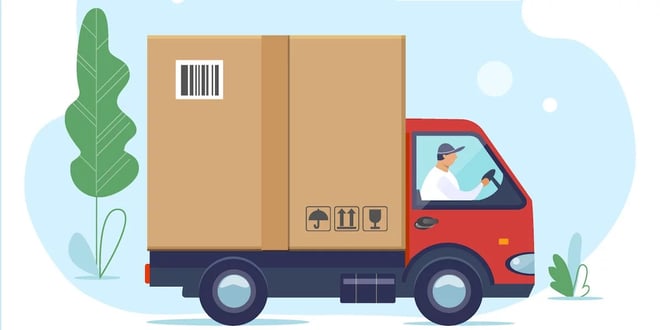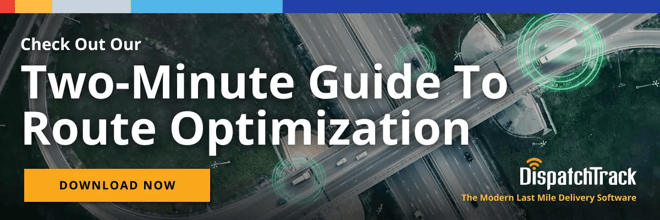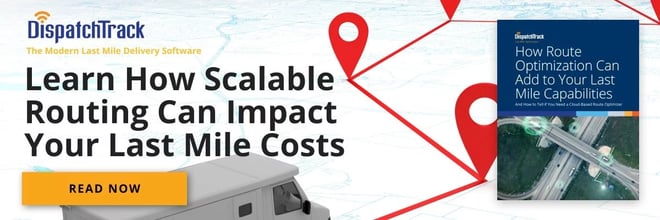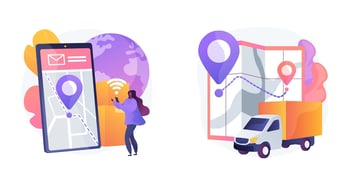Planning routes is complicated—especially when you’re dealing with a host of constraints and factors, from weather conditions, road closures, and congestion to vehicle breakdowns and fluctuating order volumes. These factors affect delivery times and must be considered in finding the best routes—but it’s virtually impossible to account for all of them manually.

Fortunately, in the modern era there’s a solution to this problem: AI-powered routing. With a route optimization solution that’s been equipped with AI- and machine learning-based capabilities, you gain unmatched computing abilities and the ability to optimize routes in a matter of minutes.
Needless to say, artificial intelligence and machine learning—along with cloud computing and other modern technologies—are dramatically transforming route optimization. AI and machine learning have the ability to consider huge numbers of possible routes against a whole host of constraints to generate efficient delivery routes in record time. In short, it’s hard to overstate how much artificial intelligence can impact route planning.
The Impact of Artificial Intelligence in Route Optimization
Now, before we go any further, let’s talk about exactly what we mean by AI. Historically, it was possible to generate routes simply through mathematical brute force—i.e. generating as many conceivable routes as possible and then analyzing which one was the shortest. But with AI you can build systems that get better at predicting the ideal route over time. How is this possible? Because machine learning and AI algorithms are capable of uncovering trends and correlations in gigantic quantities of data that human beings would simply never be able to uncover with the naked eye.
This means that the route planner can identify more and more of the factors that correlate with efficient routes over time. The more routes you plan with it, the better it gets at predicting driver behavior, traffic patterns, and more—which means that ETAs for particular stops go from being guesswork with large windows to precise and accurate estimates based on real data.

AI solutions are always learning from the information they gather and analyze so they can come up with more predictive strategies and recommendations. Artificial intelligence can turn historical traffic data, previous routes, customer locations, current traffic notes, and even particular truck and driver data into more optimal routes. Compare this to the alternative: if you have a route planner that always spits out routes that are efficient but lack reliable ETAs, you’re stuck manually adjusting those ETAs for every route in order to avoid disruptions. This means that you’re pouring person-hours back into fixing the work of a solution that was supposed to automate this process.
With AI, you can avoid that element of human rework—the algorithm really can do the heavy lifting, even in situations where the parameters and constraints are incredibly complex. It’s easy to imagine what some of the benefits here might be:
Minimizing Lost Time
A report entitled "Cost of Congestion to the Trucking Industry" revealed that traffic congestion costs the trucking industry some $74.5 billion annually, which are added to the industry's overall operational cost. That's equal to 1.2 billion hours of lost productivity or around 425,533 truck drivers stuck in traffic for the whole year. Fleets lose $6500 per truck every year due to traffic congestion.
That was five years ago. Since 2016, e-commerce has grown exponentially—especially in 2020 and 2021 due to the coronavirus crisis. The high demand for online shopping isn't going away anytime soon either and more businesses are offering both next-day and same-day deliveries. E-commerce is pushing more drivers and vehicles on the road with worsening traffic and shorter timeframes.
A route planning solution is the best way to cut down lost time due to traffic congestion. A delivery route planner ensures that drivers are given the fastest routes, or routes with less idle time due to heavy traffic. With the power of artificial intelligence in tow, you can more effectively anticipate and avoid potential traffic situations by gathering and analyzing congestion data over time.
Offering Faster Delivery Times
It's not easy to compete with giants like Amazon and Walmart, but with an AI-powered route planner, smaller businesses can go head-to-head with the big brands. Rapid delivery route planning is key to ensuring that orders are dropped off cost-effectively and on time. Since AI helps speed up calculation time, you can easily route orders for the next—or even the same—day. And because your routes are more efficient, you can complete more deliveries in a given day.
By the same token, faster, more precise delivery routing means that you can be more agile when it comes to accommodating last minute changes or additions. In the manual route-planning era, it was difficult to make adjustments to or extract any extra capacity out of routes that had already been set. But with dynamic route optimization powered by AI technology, you can adapt to changing circumstances quickly and easily.

Powering Cost Savings
The less time each truck in your fleet spends on the road per stop, the more cost savings you can enjoy as a company. Fuel expenses are reduced significantly when drivers are given the fastest routes. And fuel costs, after all, account for a large percentage of a business's overall transportation costs.
Aside from savings on fuel bills, businesses also get to save money with the automation that AI-powered delivery route planners provide—seeing as they eliminate laborious processes in manual route planning. Saving labor hours is obviously another big opportunity for cost savings. And, of course, this is in addition to the reduced fuel usage we talked about above, plus less fleet wear and tear, etc. etc.
E-commerce is growing at a rate that no one expected due to the continuous threats and major changes brought by the COVID-19 pandemic. Thus, businesses looking to compete with giant brands must ensure that all their fleets are taking the most optimal routes. Fortunately, AI-powered route planners can help businesses ensure fast and cost-effective deliveries despite the influx of orders, more congested roads, and fundamental complexity of last mile routing.






